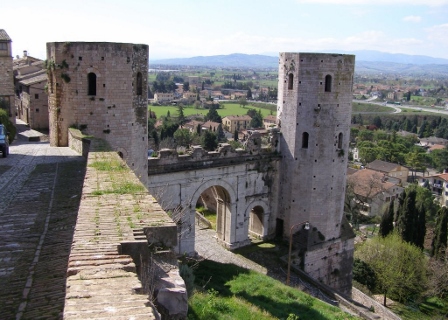
WTI Magazine #82 2016 August 19
Author : I borghi più belli d'Italia Translation by:
Spello is as valuable a book composed of many pages of which to browse quietly. Starting from the south (the area of "Borgo") climbing up to Porta dell'Arce (the "Belvedere"); you can visually cover the history of a place where you can breathe in the ancient Umbrian, Roman, Medieval and Renaissance presence. Porta Consolare was already the main entrance at the time of the Roman settlement further downstream, near the road that breaks away from the Via Flaminia.
The three barrel vault gate opens into the Augustan city walls, on top there are three statues from the roman republican era found in the area of the Amphitheatre. On top of a medieval tower attached to the gate, stands an olive tree, symbol of peace and of the more typical local product, olive oil.
The majestic Roman gate leads us into the popular Terziere Porta Chiusa, one of three districts, the others are Mezota and Posterula, in which Spello was divided during the middle Ages. You can see the tower houses built one next to the other in the narrow alleys, they were built using pink and white limestone quarried from the nearby Subasio Mountain. Carrying along Via Consolare, at the crossing with Via St. Angelo you will find Chapel of Tega, which has a small hall with a frescoed transept vault where there is a painting of the Crucifixion by Niccolò Alunno (1461).
Just beyond the chain that divides Porta Chiusa from Terziere Mezota on the right you will find the main church of the village, the Church of S. Maria Maggiore, already known in the XI century it was finished in 1285 (from the twelfth century on it was a Collegiate church). Intervention during the XVII century (1644) extended the central part and replaced the original façade, which preserves the Romanesque friezes on the portal. The interior is a real art gallery, starting with the Baglioni Chapel frescoed in 1501 by Pinturicchio, an Umbrian painter famous for his decorative sense that is festive and friendly. On the right, in the painted architectonic frame, there is a self-portrait of the painter. There is also is the beautiful Madonna and Child by Pinturicchio, in addition to other frescoes by his school. And on the ends of the wooden choir stalls you can also admire two frescoes by Perugino (1520).
The floor is made from sixteenth century Deruta majolicas. Adjacent to the church, Palazzo dei Canonici houses the Municipal picture gallery. Following the aro-mas of good typical cookery and the scent of flowered balconies you arrive at the Romanesque Church of San Andrea, of which you can admire the plait arched lintel of the portal and the fourteenth century altar, in addition to the fifteenth century frescoes and the painting by Pinturicchio and his pupils (Madonna and Child with Saints, 1508).
Walking along Via Cavour, you arrive at Piazza della Repubblica. The original thirteenth century part corresponds to the pointed arched porch on the left, which supports the sixteenth century Fountain of Pope Julius III. In the Palace there are significant Roman finds, such as the Rescript of Constantine (330 B.C.) which granted privileges to the city. The longest side of the square is closed by Rocca Baglioni (1358) which was turned into a family residence by Adriano Baglioni in 1572. In the square, you can admire the small Church of San Filippo, an eighteenth century work by Piermarini. Carrying along Via Garibaldi, past the largest private building, Palazzo Cruciani (XVII-XVIII sec.), now the Town Hall you arrive in Piazza Mazzini, where San Lorenzo the second Collegiate church rises, built in the twelfth century it was then modifie in 1540.
In this place you will find the eighteenth century Chapel of the Sacrament, possibly built by Piermarini, and sixteenth century marquetry of the choir stalls.Terziere Mezota ends at Via Giulia, it is here that the walk to the top of the village through the Terziere Pusterola begins. On the crossroads with Via Arco di Augusto you can see the ruins of Porta Romana, which opened into the Augustan wall.
Beyond this is the Subasio Civic Theatre, built at the end of the eighteenth century, and walking along Via Giulia, you can enjoy its views, squares and delightful alleys. The walk continues to the Oratory of San Biagio, home to the hospital run by laymen (1430). At the end of the street, closed by fourteenth century walls, is the Complex of the Clarisses (church and convent, 1320). The short climb up Via Capuccini through what remains of the ancient Porta dell'Arce, at the top of Spello is the Belvedere.
Large stone blocks from Roman buildings bear witness to the thousand year history of the place. Carrying along the walls of the Monastery of the Capuchins, you go down the steep via Torre del Belvedere toward the Church of S. Martino, a place of worship with Roman origins (XII century) where you will find yourself in the Terziere di Mezota again. Walking along Via delle Mura Vecchie you will get to the monumental Porta Venere, built during the age of Augustus, its elegant three barrel vault structure is enhanced by the Torri di Properzio (Towers of Properzio).
From here you leave the Roman city walls and reach the ruins of the Roman Amphitheatre (first century A.D.) and the Church of San Claudio, which has kept intact the pure and primitive Romanic characteristics dictated by Franciscan simplicity. Going outside this stretch of the Augustan Walls you come back to Porta Consolare, where the walk started.
THE NAME
Called Hispellum by the Romans who made it a municipium, the name seems to derive from its legendary founder, Ispeo Pelisio, one of the companions of Aeneas, who got lost during their journey.
LOCAL DISHES
Thanks to its peculiar qualities the olive-oil is one of the finest in Italy.Black truffle is picked in the forests of the area, honey is made from flower essences, which stand out because of their clarity and perfume, Grechetto, Merlot and Sangiovese wine made from grapes selected are also excellent.



